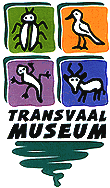
E - MAIL
Researcher
Mrs Lauretta Mahlangu
Preparator
Department of Vertebrates
Herpetology Collection


Dr. Vivian FitzSimons
The Herpetology collection contains one of the most important collections of African reptiles and amphibians world wide. It consists of complete specimens in alcohol, skeletal material (including tortoise/turtle shells), skins, photographic slides, and black and white prints of mainly southern African species, representing at least 90% of described species from subcontinent.
More than 225 taxa are represented by primary specimens.
The objective is to document and study biogeographic systematics of Southern African reptile and amphibian biodiversity, based on voucher specimens housed in this and other museums and to disseminate this information via scientific publications, popular articles, lectures, slides shows and displays.
![]() South African Snakes Click
South African Snakes Click
![]() Southern African reptile species list Click
Southern African reptile species list Click
![]() CITES (List of endangered reptiles) Click
CITES (List of endangered reptiles) Click
![]() EMBL Reptile Database Click
EMBL Reptile Database Click
![]() African Journal of Herpetology
African Journal of Herpetology ![]() Herpetological Association of Africa Click
Herpetological Association of Africa Click
![]() Career in Herpetology Click
Career in Herpetology Click
|
|
|
![]() Namib Web-Footed Gecko Palmatogecko rangei click
Namib Web-Footed Gecko Palmatogecko rangei click
![]() The Nile Crocodile Crocodylus niloticus click
The Nile Crocodile Crocodylus niloticus click
![]() The Bushveld Lizard Heliobolus lugubris click
The Bushveld Lizard Heliobolus lugubris click
![]() The African Bullfrog Pyxicephalus adspersus click
The African Bullfrog Pyxicephalus adspersus click
![]() Spider eats snake click
Spider eats snake click
THE COLLECTION
The section houses approximately 83 300 specimens, of which ± 80 000 are from the southern African subregion. Comparative material from the rest of Africa, Madagascar, Australia, Europe and some from the rest of the world, is also present. The bulk of the collection consists of preserved specimens fixed in formalin and stored in alcohol. Dried material is in the form of skeletons, skins, and whole animals (mainly tortoises). In recent times a start was made to preserve tissue samples of suitable fresh specimens in alcohol.
ACTIVITIES
Continuous accessioning of material collected on field trips in addition to specimens donated by private individuals and organizations. The computerizing of the collection will help to manage the collection more efficiently. Ultimately, to facilitate information dissemination, the department plans on posting its holdings on the web.

COLLECTION MANAGEMENT
All specimens are required to have minimum data of locality, preferably with exact co-ordinates, collecting date and the name of the collector, who might be able to provide additional information.
SPECIMENS of COLLECTION in DATABASE click
Type collection: The more than 225 Holo type specimens are stored in special containers in the main strongroom on the ground floor of the museum, while the Para types are kept separate from the main study collection in a departmental strongroom. Arrangement is alphabetical by family and species.
Main collection: Continuous accessioning of material collected on field trips in addition to specimens donated by private individuals and organizations. Specimens are only accessioned if they comply to the above mentioned minimum requirements. The collection is focused on the southern African sub-region and the faunal relationship with the rest of the Ethiopian region. However, smaller collections of comparative material from Madagascar, Australia, Europe and some from the rest of the world have been accumulated over the years, mainly by exchange with other institutions.
Recently a start was made to include a tissue collection.
Standard preservation procedures are followed:
a) Fixing in 4% formaldehide solution buffered with hexamin. Cross referenced tissue samples in 98% ethanol are kept of suitable fresh specimens.
b) Preservation, after washing, in 70 % ethanol.
Accessioning:
All accepted new specimens are entered manually in the master catalogue and thereby are allocated a sequential catalogue number. Hand written tags, with the museum number and collection data are attached to the specimen. After identification the individual is placed in a jar with the appropriate species label and a geographic allocation. At present the extant card index by individual taxon is maintained.
|
|
|




